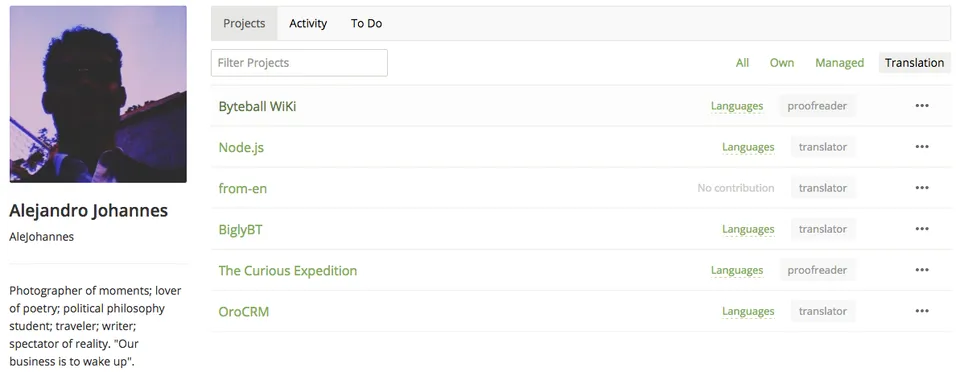Github Repository
https://github.com/nodejs/i18n
Project Details
By definition, Node.js is a Java Runtime Environment (JRE). But it is more than just that. While common JREs serve as machine backups that allow users to smoothly run JavaScript on their browsers and applications, this open-source project functions as an app that manages Java code by itself. It's practical uses for developers are endless. It grants an extraordinarily versatile platform for designing code, programs, websites and other applications. And that isn't all: Node provides a virtual facility for testing the proper work of Java-driven programs and devices –and their planned updates–, helping to find bugs, solve errors, fix code and vastly improving their performance.
I believe all the amazing uses of Node are to be considered by themselves and I declare myself a fan of the project. But, besides, I support it for its working properties as a medium for bringing to reality countless creations that can be as good as Node itself. Imagination (and Java) is the limit! The open translation of Node to thirty-three (33) languages proves the advantages of open-source projects when it comes to diversification of knowledge and worldwide spreading of useful tools.
Ahead, there is the link of the program's webpage:
Contribution Specifications
Translation Overview
This is my 16th contribution to Node.js as a translator. For this collaboration, I continued my previous work on CHANGELOGS_ARCHIVE.md file, translating Node's changelogs of versions between 0.1.12 and 0.0.3. With this collaboration, I finished the translation of the document!
A changelog is a registry of all the changes made on determined project for each one of its versions. The files created for such purpose list modifications on internal components, substitutions of protocols, updates, deprecations, addition of supported programs, new functions, corrected errors and fixed bugs. To sum up: every single feature that started being applied in each version must be specified and described in this registry. The objective of that is providing a timeline of the development of the project and, by doing so, helping programmers to check any detail they need to understand the way it came to be what it is and make it better in the future.
I can refer to one of the logs I translated to illustrate the dynamics of the changelog. This one is from Version 0.1.8:
- "Feature: setTimeout() for node.tcp.Connection"
There are two concepts involved in this log. Being able to understand it requires that we address each of them particularly.
The first one is TCP. The Transmission Control Protocol (TCP) is one of the core protocols that rule the behavior of Internet –and alike– connections. Its function is to mediate between the Internet Protocol (IP) and the applications that are run by Internet. The TCP optimizes data transmission on the web by reducing errors to a minimum, detecting missing data and requesting the server for its resupply when something goes wrong. Its first implementation was in 1974, under the name of Internet Transmission Control Program; in 1981, by its Version 4, its name had already changed to the actual. Due to its great functionality and worldwide spread with the Internet itself, the main composition of TCP has barely changed in the last thirty-five years.
The other term we need to define is "timeout". In computer science, a timeout is a parameter that determines how much time will a program wait for the execution of certain task before producing certain event, that event being, usually, the closure of such task. Timeouts are useful to save machine resources –especially memory– and user's time, avoiding the saturation and stalling of the system with an indefinite number of processes that, because of specific maintained conditions, cannot be completed. I explain the following example GIF step by step: 1) Super-rough cop Rosa Díaz (Brooklyn Nine-Nine) is a program with a timeout condition; 2) You are the process wasting her time; 3) You tested the limits of her patience; 4) She got tired of waiting; 5) She is coming for you.

Knowing these concepts, the comprehension of the quoted entry becomes attainable. Version 0.1.8 included the introduction of a function [setTimeout()] to configure a timeout on the process of Node's connection with the TCP [node.tcp.Connection]. The developers found a spot where resources could be managed in a better way, enabled the possibility to apply the aforementioned function there and boosted the performance of Node.
You can check some references here for more information about those concepts:
- https://www.techopedia.com/definition/5773/transmission-control-protocol-tcp
- https://en.wikipedia.org/wiki/Transmission_Control_Protocol
- https://www.webopedia.com/TERM/T/TCP.html
- https://www.webopedia.com/TERM/T/time_out.html
- https://dictionary.cambridge.org/dictionary/english/timeout
- https://en.wikipedia.org/wiki/Timeout_(computing)
All changes included in each one of the versions of the project are formatted as pull-request commits. Id est, they are presented as very brief comments about the action that was suggested, are normally written with imperative verbs, and have a strict limitation on their number of characters (so even complex ideas are reduced to a small amount of words). These specifications made the translation of this document a challenge. However, it was satisfactorily achieved (THE WHOLE FOLDER, YES!). As you will see in the examples below, the name of the developer who provided each log is often referred inside parenthesis at the end of it.
Work example #01:
English:
- Enhance repl library (Ray Morgan)*
Spanish:
Habilitar librería repl (Ray Morgan)*
Work example #02:
English:
Bugfix: node.encodeUtf8 was broken. (Connor Dunn)
Spanish:
Corrección de bug: node.encodeUtf8 estaba dañada. (Connor Dunn)
Languages
This translation was made from English to Spanish.
I got plenty experience translating and proofreading this project as an Utopian contributor. I collaborate here as translator and Language Moderator of the Da-Vinci/Utopian Spanish translation team. Besides this project, I have experience translating and proofreading The Curious Expedition, Ancap-ch, Byteball Wiki, OroCrm and BiglyBT.
Word Count
- The amount of words translated in this contribution is: 1047.
- The total amount of words translated in this project (as a Da-vinci/Utopian translator) is: 16476.
Previous Translations of the Project
- Contribution N'01. Submitted on September 13th, 2018.
- Contribution N'02. Submitted on September 15th, 2018.
- Contribution N'03. Submitted on September 17th, 2018.
- Contribution N'04. Submitted on September 19th, 2018.
- Contribution N'05. Submitted on September 21th, 2018.
- Contribution N'06. Submitted on September 22th, 2018.
- Contribution N'07. Submitted on September 23th, 2018.
- Contribution N'08. Submitted on October 1st, 2018.
- Contribution N'09. Submitted on October 8th, 2018.
- Contribution N'10. Submitted on October 14th, 2018.
- Contribution N'11. Submitted on October 15th, 2018.
- Contribution N'12. Submitted on October 18th, 2018.
- Contribution N'13. Submitted on October 21st, 2018.
- Contribution N'14. Submitted on October 24st, 2018.
- Contribution N'15. Submitted on October 27st, 2018.
Proof of Authorship
This translation was made between October 27th and 28th, 2018. You can check the translation record in my Crowdin account [here], the activity on the project's Crowdin [here] and a summary of recent additions to the project [here].



